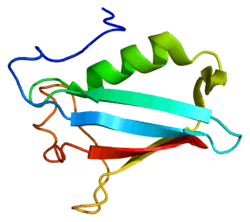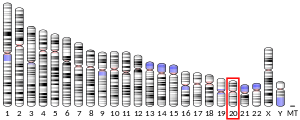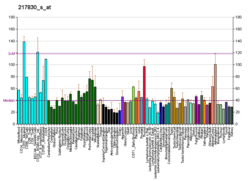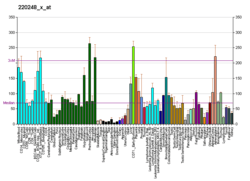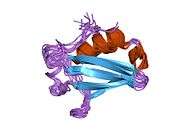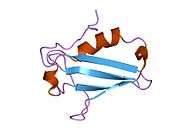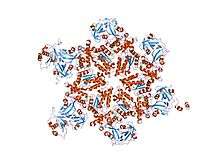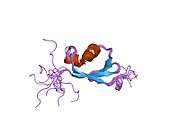NSFL1C
NSFL1 cofactor p47 is a protein that in humans is encoded by the NSFL1C gene.[5][6]
N-ethylmaleimide-sensitive factor (NSF) and valosin-containing protein (p97) are two ATPases known to be involved in transport vesicle/target membrane fusion and fusions between membrane compartments. A trimer of the protein encoded by this gene binds a hexamer of cytosolic p97 and is required for p97-mediated regrowth of Golgi cisternae from mitotic Golgi fragments. Multiple transcript variants encoding several different isoforms have been found for this gene.[6]
Interactions
NSFL1C has been shown to interact with Valosin-containing protein.[7]
gollark: ???
gollark: Why does the military's political-ness matter here again?
gollark: So it seems that Asch's conformity experiment replicates fine, I will look at the Milgran obedience one.
gollark: If you have enough of them and no special bias it'll just average out to normal population political views.
gollark: I will check, hold on.
References
- GRCh38: Ensembl release 89: ENSG00000088833 - Ensembl, May 2017
- GRCm38: Ensembl release 89: ENSMUSG00000027455 - Ensembl, May 2017
- "Human PubMed Reference:". National Center for Biotechnology Information, U.S. National Library of Medicine.
- "Mouse PubMed Reference:". National Center for Biotechnology Information, U.S. National Library of Medicine.
- Zhang QH, Ye M, Wu XY, Ren SX, Zhao M, Zhao CJ, Fu G, Shen Y, Fan HY, Lu G, Zhong M, Xu XR, Han ZG, Zhang JW, Tao J, Huang QH, Zhou J, Hu GX, Gu J, Chen SJ, Chen Z (Nov 2000). "Cloning and Functional Analysis of cDNAs with Open Reading Frames for 300 Previously Undefined Genes Expressed in CD34+ Hematopoietic Stem/Progenitor Cells". Genome Res. 10 (10): 1546–60. doi:10.1101/gr.140200. PMC 310934. PMID 11042152.
- "Entrez Gene: NSFL1C NSFL1 (p97) cofactor (p47)".
- Uchiyama, Keiji; Jokitalo Eija; Lindman Mervi; Jackman Mark; Kano Fumi; Murata Masayuki; Zhang Xiaodong; Kondo Hisao (Jun 2003). "The localization and phosphorylation of p47 are important for Golgi disassembly–assembly during the cell cycle". J. Cell Biol. United States. 161 (6): 1067–79. doi:10.1083/jcb.200303048. ISSN 0021-9525. PMC 2173005. PMID 12810701.
Further reading
- Maruyama K, Sugano S (1994). "Oligo-capping: a simple method to replace the cap structure of eukaryotic mRNAs with oligoribonucleotides". Gene. 138 (1–2): 171–4. doi:10.1016/0378-1119(94)90802-8. PMID 8125298.
- Yu W, Andersson B, Worley KC, et al. (1997). "Large-Scale Concatenation cDNA Sequencing". Genome Res. 7 (4): 353–8. doi:10.1101/gr.7.4.353. PMC 139146. PMID 9110174.
- Kondo H, Rabouille C, Newman R, et al. (1997). "p47 is a cofactor for p97-mediated membrane fusion". Nature. 388 (6637): 75–8. doi:10.1038/40411. PMID 9214505.
- Suzuki Y, Yoshitomo-Nakagawa K, Maruyama K, et al. (1997). "Construction and characterization of a full length-enriched and a 5'-end-enriched cDNA library". Gene. 200 (1–2): 149–56. doi:10.1016/S0378-1119(97)00411-3. PMID 9373149.
- Rabouille C, Kondo H, Newman R, et al. (1998). "Syntaxin 5 is a common component of the NSF- and p97-mediated reassembly pathways of Golgi cisternae from mitotic Golgi fragments in vitro". Cell. 92 (5): 603–10. doi:10.1016/S0092-8674(00)81128-9. PMID 9506515.
- Hu RM, Han ZG, Song HD, et al. (2000). "Gene expression profiling in the human hypothalamus-pituitary-adrenal axis and full-length cDNA cloning". Proc. Natl. Acad. Sci. U.S.A. 97 (17): 9543–8. Bibcode:2000PNAS...97.9543H. doi:10.1073/pnas.160270997. PMC 16901. PMID 10931946.
- Deloukas P, Matthews LH, Ashurst J, et al. (2002). "The DNA sequence and comparative analysis of human chromosome 20". Nature. 414 (6866): 865–71. Bibcode:2001Natur.414..865D. doi:10.1038/414865a. PMID 11780052.
- Meyer HH, Wang Y, Warren G (2002). "Direct binding of ubiquitin conjugates by the mammalian p97 adaptor complexes, p47 and Ufd1–Npl4". EMBO J. 21 (21): 5645–52. doi:10.1093/emboj/cdf579. PMC 131076. PMID 12411482.
- Uchiyama K, Jokitalo E, Kano F, et al. (2003). "VCIP135, a novel essential factor for p97/p47-mediated membrane fusion, is required for Golgi and ER assembly in vivo". J. Cell Biol. 159 (5): 855–66. doi:10.1083/jcb.200208112. PMC 2173386. PMID 12473691.
- Strausberg RL, Feingold EA, Grouse LH, et al. (2003). "Generation and initial analysis of more than 15,000 full-length human and mouse cDNA sequences". Proc. Natl. Acad. Sci. U.S.A. 99 (26): 16899–903. Bibcode:2002PNAS...9916899M. doi:10.1073/pnas.242603899. PMC 139241. PMID 12477932.
- Nagahama M, Suzuki M, Hamada Y, et al. (2003). "SVIP Is a Novel VCP/p97-interacting Protein Whose Expression Causes Cell Vacuolation". Mol. Biol. Cell. 14 (1): 262–73. doi:10.1091/mbc.02-07-0115. PMC 140243. PMID 12529442.
- Uchiyama K, Jokitalo E, Lindman M, et al. (2003). "The localization and phosphorylation of p47 are important for Golgi disassembly–assembly during the cell cycle". J. Cell Biol. 161 (6): 1067–79. doi:10.1083/jcb.200303048. PMC 2173005. PMID 12810701.
- Ota T, Suzuki Y, Nishikawa T, et al. (2004). "Complete sequencing and characterization of 21,243 full-length human cDNAs". Nat. Genet. 36 (1): 40–5. doi:10.1038/ng1285. PMID 14702039.
- Beausoleil SA, Jedrychowski M, Schwartz D, et al. (2004). "Large-scale characterization of HeLa cell nuclear phosphoproteins". Proc. Natl. Acad. Sci. U.S.A. 101 (33): 12130–5. Bibcode:2004PNAS..10112130B. doi:10.1073/pnas.0404720101. PMC 514446. PMID 15302935.
- Gerhard DS, Wagner L, Feingold EA, et al. (2004). "The Status, Quality, and Expansion of the NIH Full-Length cDNA Project: The Mammalian Gene Collection (MGC)". Genome Res. 14 (10B): 2121–7. doi:10.1101/gr.2596504. PMC 528928. PMID 15489334.
- Rual JF, Venkatesan K, Hao T, et al. (2005). "Towards a proteome-scale map of the human protein-protein interaction network". Nature. 437 (7062): 1173–8. Bibcode:2005Natur.437.1173R. doi:10.1038/nature04209. PMID 16189514.
- Olsen JV, Blagoev B, Gnad F, et al. (2006). "Global, in vivo, and site-specific phosphorylation dynamics in signaling networks". Cell. 127 (3): 635–48. doi:10.1016/j.cell.2006.09.026. PMID 17081983.
This article is issued from Wikipedia. The text is licensed under Creative Commons - Attribution - Sharealike. Additional terms may apply for the media files.
